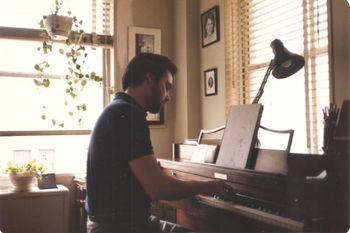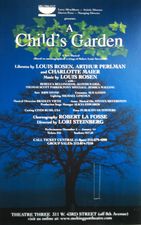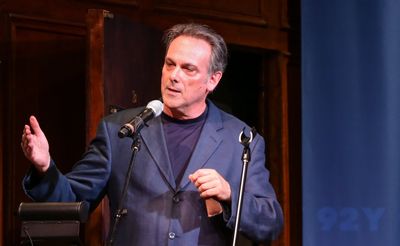


Louis Rosen: A Serious Musician in a Porkpie Hat
Posted on October 4, 2016 by Alix Cohen in Living Around

Louis Rosen, composer/songwriter/librettist/musician/author/educator is a Jewish white man for whom black experience profoundly resonates. He’s also a musician with an affinity for serious poetry. My first impression of the artist reflected neither of these attributes. Comfortably ensconced on a stool at New York’s Birdland, he sang his own songs, playing acoustic guitar. They were, as I said in my review, literate, sincere, folksy… a graceful advocate of understatement. It felt like the 1970s.

The second part of the program consisted of selections from Dream Suite, music by Rosen, words by Langston Hughes. I wrote, Songs arrive full blooded and black, hybrid American opera-without libretto… roots lay in gospel, R & B, boogie woogie, blues… Like George Gershwin, here was an artist who effectively burrowed under the skin of black culture. Rosen, however, had no need for theatrical thru-line. Each lyric could be married to music specific unto its sentiments.
A little research unearthed the prolific composer’s Twelve Songs on poems by Maya Angelou, One Ounce of Truth-The Nikki Giovanni Songs (with Dream Suite, these comprise The Black Loom Trilogy)and The Ache of Possibility utilizing more Giovanni. What, I wondered was the source of such fellow feeling? What was his journey?
Roots
Rosen was raised on Chicago’s far South Side in a mile square enclave of middle class, Jewish white folks who built the community just after World War II. It was “A good place to buy a home, raise children, build a synagogue, and enjoy the fruits of family life.”

Starting when he was 10, and escalating to “white flight panic mode” after the Martin Luther King assassination, something uncomfortable happened to his secure, picturesque neighborhood. Despite avowed lack of prejudice, as black people traded up and moved in, Rosen’s white buddies and their families moved out. The Jewish Community Center and then the Temple shut down. “People succumbed to the fear their homes wouldn’t be worth anything after awhile.” There’s regret in his response and a tinge of former confusion. “It was happening all over the country.”
The boy and his contemporaries were in the eye of the storm. There had always been blacks and Latinos in school “you assumed the price for entering the Men’s Room (in high school) was a quarter,” but never like the incoming wave. Still Rosen was physically assaulted only once and then by two Chicago policeman because he had long hair. They threw him against the patrol car, “did a mildly rough search, no doubt looking for drugs, and found none. It wasn’t serious, but it taught me what it is to be targeted based on appearance.”

His family stayed another five years, then moved a few miles away. Mrs. Rosen, like many others, suffered the loss of her dream house and hopes of growing old within the community that had nurtured her marriage. It wasn’t until age 40, when he interviewed past residents in an effort to fully understand the phenomenon, the artist found empathy for what occurred.
Shakespeare to Sondheim
Though his family played an American Songbook version of “Name That Tune” around the dinner table, young Louie Rosen was into R & B. He joined a garage band performing – before closure – at The Jewish Community Center and bar mitzvahs. By 16, he’d dispensed with drums teaching himself piano and guitar. He also began to write, albeit without knowledge of notation. Singer/songwriters made him want to be a musician. When neighborhood street sounds changed, the teenager heard so much soul music, it annoyed, rather than intrigued him. “If I have any regret, it’s that I never went down to the blues clubs in Chicago.” I glance at the porkpie hat.

After an ambivalent Gap Year, Rosen buckled down to college and then The Chicago Conservatory. He might, he conjectures with implicit shrug, have been a basketball coach or history teacher were it not for this chapter. Extremely broad programs included jazz orchestration and a class on Stravinsky.
Rosen kind of fell into theater. The last year at school, he shared a house with his playwright brother; thespians converged. At 22 and wet behind the ears, he was hired to compose a score for Romeo and Juliet and six songs for an Aristophanes play. It was the first time he coupled music with verse. Supporting himself by teaching, he went on to score Macbeth and Winter’s Tale inadvertently becoming the city’s go-to Shakespeare guy.
“I had no experience with black culture; classical music doesn’t expose you to African American musicians.” A self proclaimed serious artist, the only theater composers he liked were Gershwin, Weil, Bernstein, and Sondheim. Exceptions might be made for those musicals attacking important subjects like Rodgers and Hammerstein’s South Pacific.
In 1981, NYU inaugurated a pilot graduate program for theater writing. As a prologue, eight musicians were invited to spend three weeks in workshop with Stephen Sondheim and Hal Prince. Rosen came to New York. “At this point, Sondheim had just written Sweeney Todd. The 1970s made us think you could do serious, experimental theater.” His voice takes on energy in recollection.

The group met in a loft on Crosby Street. Rosen describes it as looking like “a heroin den.” He loved that uptown guys would come down for this. “The first thing I had to do as a young man was get over the fact that I was in the room with Sondheim and he was treating me like I had a right to be there. Once I did that, I had to listen very closely. He was unpretentious, but terse, with laser like precision zeroing in on problems…” The student especially learned form, lyric writing for character, and the significance of musical gestures that make take one from dialogue into song. They still occasionally communicate.
“I really liked Hal too. He criticized one of my songs in a way that to this day is the best put down I’ve ever had: `I feel the music is gratuitous’ and he was right, it was generic.” Up go the eyebrows.
That December, Rosen returned to New York (and stayed) entering NYU’s MFA program. A two week intensive with Leonard Bernstein was held on 47th Street, upstairs, next to The Gaiety Deli in a space donated by The Shuberts. “He was a showman. When he walked in, he stopped in the doorway and looked around until all eyes turned.” The Maestro wore a cape.
The first session was scheduled for three hours. When time was up, a loquacious Bernstein suggested if someone would get him dinner, he’d stay until he had to be at the theater. “They bring this greasy chicken. He’s eating and speaking with tremendous insight about Mark Blitzstein. There are these movie posters up on the wall. In the middle of a sentence, he takes a drumstick bone and says, `Let me see if I can hit Lana Turner in the tits,’ throws it, and goes on without missing a beat.” Rosen grins.
When a couple of students brought in a song with what they thought was a Greek feel, Bernstein sat at the piano and offered 20 folk music motifs on which they might’ve built. “He said, steal from the real and make it your own, don’t give me faux Greek…He enjoyed astonishing us.”


Avoiding what he felt was the language of popular music, Rosen wrote instead for Brecht’s Galileoand Shakespeare’s The Tempest at Chicago’s Goodman Theatre. “It’s like an actor getting a classical role. No one can do the definitive version.” He authored a successfully produced musical with Tom Bishop called Book of the Night and a song cycle entitled “A Child’s Garden of Verses” that blossomed into a second musical illuminating the life of Robert Louis Stephenson.
“I was really writing about my own childhood, the facts of his life in  tandem with my emotional and musical crisis.” The piece is set on the last day of summer. An older Stephenson looks back working through a writer’s block. “It was interesting the degree to which I could communicate personally with someone else’s words.” The song cycle, what we called “concept albums” in the 1960s and 1970s, is an ideal form for Rosen. “Stories can be told, an emotional journey created, characters portrayed, but unlike musical theater, all the dots don’t need to be connected.”
tandem with my emotional and musical crisis.” The piece is set on the last day of summer. An older Stephenson looks back working through a writer’s block. “It was interesting the degree to which I could communicate personally with someone else’s words.” The song cycle, what we called “concept albums” in the 1960s and 1970s, is an ideal form for Rosen. “Stories can be told, an emotional journey created, characters portrayed, but unlike musical theater, all the dots don’t need to be connected.”
The South Side
Rosen was now in therapy. It was time to face the past. Awarded the last NEA New American Works Grant given to an individual, he intended to create a musical theater piece based on growing up on the South Side. Six of the evocative songs he included with his grant application ended up on the CD South Side Stories. For perhaps the first time, an underbelly of jazz and blues, what he calls “the blue note” can be discerned in his music. “It metaphorically means the integration of everything I’d grown up with."
…It was bungalows all in a row/Where a family dream could grow/And only Democrats knew where the bodies were buried/On the South Side…(“The South Side”)
I asked myself Why?/I asked myself, Who?/I answered some just don’t like barbecue on the/ South Side…Are we leavin’, are we stayin’?…Was the question, What to do?/Or was the question, What excuse do we use?… (“The South Side Blues”)
In the process, he realized not only that he didn’t understand what happened any better at 40 than he did at 13, but that his experience was not uncommon. “So I put aside music and started writing the book.” The South Side – The Racial Transformation of an American Neighborhood 1998
Tracking down and interviewing former black and white neighbors, Rosen created fifteen composite characters who “speak” rather like those in Our Town (Thornton Wilder) or Under Milkwood (Dylan Thomas). “I went in thinking racism was the only issue and came out understanding that fears were based on past history and the tribal nature of humankind.” A reference, in part, to the persecution of the Jewish people? Its author thinks of the edifying (nonfiction) volume as a spoken cantata. It was also something of an exorcism.


Miscommunication came up again and again:
“…knowing that blacks and Jews shared some similar experiences – you know, slavery, discrimination; we’d been partners in the civil rights struggle -I thought we had an awful lot in common. I was really surprised when certain things happened…that showed a gap between the two groups…” from a white woman
“So we felt. “Enough is enough. Fifty-fifty we don’t mind-living in an integrated community. But after that, forget it…It’s just like Tevye-you can’t look back.” …from a white man (Tevye is the protagonist in Fiddler on the Roof)
“I think I subconsciously felt we weren’t a wanted race, that it didn’t matter what you looked like, how you sounded, whether you were intelligent or educated – you just weren’t wanted, collectively….So when the Jewish people were leaving the neighborhood, I wasn’t surprised…” from a black woman
By the time Rosen started his next effort – Dream Suite, Songs in Jazz and Blues on poems by Langston Hughes – he’d read more books than he could count about the Antebellum South and a serious amount of African American poetry, from Harlem’s Renaissance to the 20th Century. “Hughes was the best… his work breaks through racial boundaries to touch the soul of humanity – racial, political, and personal….it says something worth saying.” Immersing himself in the author, Rosen devoured both autobiographies and a book of short stories. He identified with Hughes’ introspective nature.

“Most important for a composer, his poetry sings with natural ease and grace…the language is rich in imagery…yet always rooted in the American vernacular and soulfully direct in emotional expression…” The idea was to eschew art songs for settings within the broad reach of popular material.
“So called art songs by Schubert, Barber, Rorem live side by side with those of Paul Simon, Bob Dylan, Joni Mitchell, Antonio Carlos Jobim…It’s all one to me. If my musical voice is distinctive, its originality comes in the manner of synthesis…`Harlem Night Song’ (for example), starts with shades of Aaron Copeland and moves into shades of Jimmy Webb, though you don’t hear them explicitly.”
Rosen has been surprisingly successful with this approach. Much of what was written arrives so like songs it’s as if he collaborated with the lyricist. The CD of Dream Suite was inspired and recorded by Alton Fitzgerald White “we have a deep musical connection” who had been in the workshop of Book of Night and, upon recommendation, Capathia Jenkins, who became Rosen’s Muse, recording and performing with him ever since. “She and I come from completely different worlds, but the worlds become one with the work.”

“When Louie said I think I’d like to write for you, I didn’t take him seriously, but true to who he is, he called about a month after recording to tell me he started to sketch some of Maya Angelou’s poems. (one of her favorite poets)… It’s a tightrope to walk if you’re a white person trying to reflect the black experience. He gets it,” Jenkins says. Rosen’s settings are a challenge the vocalist relishes. If she doesn’t feel he’s written in her voice, that a song doesn’t speak to her, she tells him straight out. If the composer wants something “juiced” or “finessed” he speaks up. They describe Nikki Giovanni with the exact same phrases. It’s a symbiotic relationship, “an honor,” she adds.
Dream Suite was the first of the three song cycles that evolved into The Black Loom Trilogy. “If you take African American elements out of American music, you don’t have American music…That collision of cultures had a huge impact on my generation… it’s probably the most fundamental driving force in my life.”
Maya Angelou depicted the down and out with an edge Rosen found “sassy, political, and slightly angry.” He was attracted to the pride and dignity of her women. The composer also chose Angelou because the writing was a fit for Jenkins, “both her voice and being…these days I’m either writing for myself or Capathia.” Already familiar with Nikki Giovanni, he discovered over time her voice had mellowed becoming more positive. With gravity, there was new playfulness in the author’s poetry and prose. Giovanni has performed with Rosen and Jenkins. Jenkins calls her “salt of the earth.”


“At this point, the music was flowing at a pace that went beyond what I, as a lyricist, could keep up with. So every work for which I’d write music and lyrics would be matched by one or two where I set poetry to music… The journey of the three pieces is one towards light. I could personally express what I wanted to say through the content. It sang to me.” Rosen feels he’s currently finished with the black experience.
I ask how it is that religion hasn’t found its way into Rosen’s oeuvre. He’s addressed culture and history, but fixed on no Jewish writers for inspiration or raw material despite similarities in the black and Jewish experience and the environment in which he grew up. There’s a long silence. He responds by pointing to a song in South Side Stories about the relationship of a light skinned girl and dark skinned boy to which the girl’s parents object. “The original lyric was about a Jewish boy and a Gentile girl. I just wanted Capathia to sing the song, so I changed it slightly.” Except for a couple of isolated lines in two others, there are no additional references.
“I’ve struggled for years with the role of Judaism in my life. We went to synagogue, I had a bar mitzvah. By the time I was 15, Judaism had disappeared from the hood…I’ve never really felt a part of it. There are lots of things I’ve never felt a part of-like my generation…” Rosen thinks of himself as spiritual, not religious.
“My Third Act”
When James Lapine asked the composer (in 2014) to write music for his Lincoln Center production of Act One based on Moss Hart’s autobiography of the same title, Rosen hadn’t written for theater since the 2004 production of Moliere’s School for Husbands at the Westport Country Playhouse. Nor had he missed it. This is not to say Rosen hadn’t been busy. The artist almost always has several projects besides teaching Music Appreciation and Theory – everything from Bach to The Beatles – at 92Y School of Music over 30 years. He loves it. “It keeps me learning. When I learn something new I want to share it. The wow factor of discovery hasn’t gotten old for me.”

Lately, the multifaceted Rosen writes both music and lyrics in a chapter he calls more confessional than professional. “I think I was awakened to that distinction from an interview I read 30 years ago with Bob Dylan”; songs to get old by dealing with this moment in life. There are ballads, wry comments, and storysongs.
My son’s 529 Plan’s going M.I.A./My pulse rate is the opposite of A.O.K./I see rows and rows of red ink/Where there once was black/Stare into the abyss too long-/It’s gonna stare back… “The Middle Class (Used-To-Be) Blues”
“I still work a lot and I still want my work to be heard, but the desire now is driven less by large dreams than by the passion and joy of creating, then offering the work through performance and recording…The importance of being present with my wife and son, or spending a day wandering or reading in Prospect Park can’t be overstated. Social Security is visible on the horizon and as I said in `My Third Act’, eventually… I’ll be workin’ on my memoir while I’m workin’ on my tan.”

Louis Rosen’s body of work is far more extensive than that which I selected to call out.
It can be found on his website.
CDs can be purchased from the store on his website and on CD Baby.
In December Rosen will perform his own music at The Duplex in collaboration with the formidable Karen Mason, whom he’s known since Chicago. A new CD, Dust to Dust Blues, will be released in 2017, the artist hopes to record both a 15 song cycle provisionally called “I Don’t Know Anything,” and, with Darius de Haas, A Child’s Garden Song Suite, inspired by the musical theater piece. Whew.
-
0:00/3:26
-
0:00/2:33
-
0:00/2:31
-
LAST CHANCE, MARIE 3:550:00/3:55
-
LOVE AND ASHES 4:280:00/4:28
-
0:00/5:04
-
0:00/4:10
-
0:00/3:03
-
0:00/3:02
-
0:00/3:41
-
0:00/2:14
-
LIMITLESS WORLD 3:170:00/3:17
-
MORNING SOUL 3:480:00/3:48
-
0:00/4:23
-
THINK ABOUT MYSELF 2:550:00/2:55
-
0:00/3:06
-
DUST TO DUST BLUES 3:550:00/3:55
-
TIME WAS 2:580:00/2:58
-
CABIN IN THE WOOD 4:330:00/4:33
-
0:00/3:15

